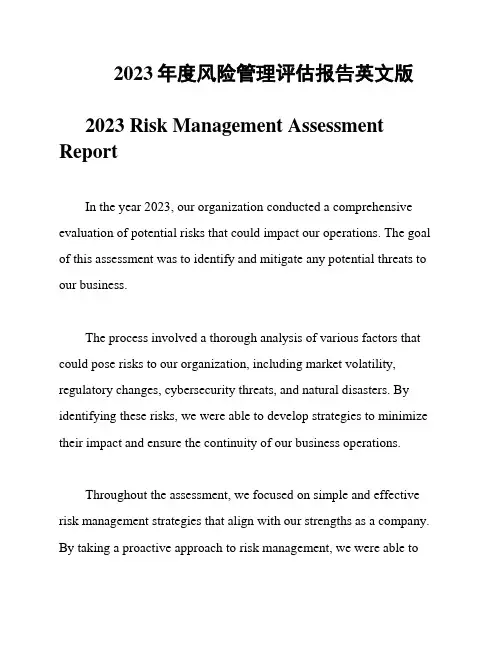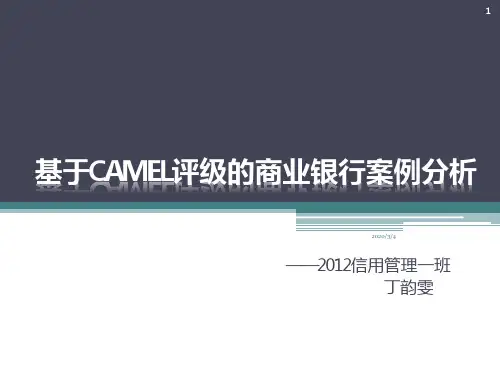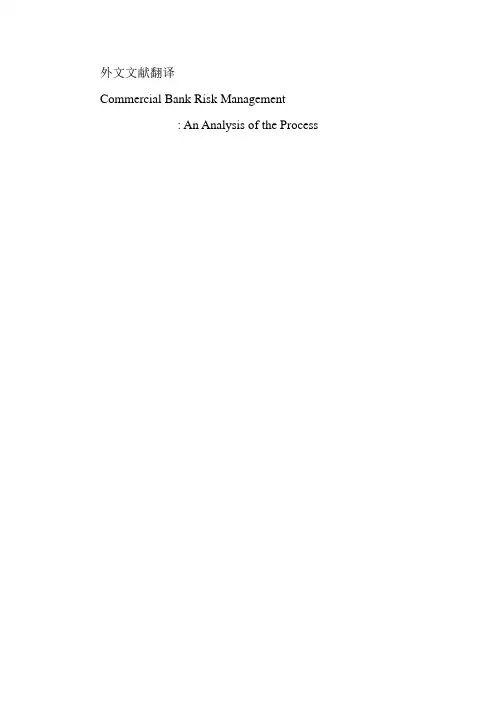商业银行经营风险评价(英文版).pptx
- 格式:pptx
- 大小:490.65 KB
- 文档页数:70

2023年度风险管理评估报告英文版2023 Risk Management Assessment ReportIn the year 2023, our organization conducted a comprehensive evaluation of potential risks that could impact our operations. The goal of this assessment was to identify and mitigate any potential threats to our business.The process involved a thorough analysis of various factors that could pose risks to our organization, including market volatility, regulatory changes, cybersecurity threats, and natural disasters. By identifying these risks, we were able to develop strategies to minimize their impact and ensure the continuity of our business operations.Throughout the assessment, we focused on simple and effective risk management strategies that align with our strengths as a company. By taking a proactive approach to risk management, we were able toanticipate potential challenges and implement measures to mitigate their impact.Moving forward, we will continue to prioritize risk management as a key component of our overall business strategy. By regularly assessing potential risks and implementing effective mitigation strategies, we aim to safeguard our business from unforeseen threats and ensure long-term success.Overall, the 2023 Risk Management Assessment Report highlights our commitment to identifying, evaluating, and addressing potential risks to our organization. By proactively managing risks, we can better protect our business and position ourselves for continued growth and success in the future.。




外文文献翻译Commercial Bank Risk Management: An Analysis of the Process外文文献:Commercial Bank Risk Management: An Analysis of the Process AbstractThroughout the past year, on-site visits to financial service firms were conducted to review and evaluate their financial risk management systems. The commercial banking analysis covered a number of North American super-regionals and quasi±money-center institutions as well as several firms outside the U.S. The information obtained covered both the philosophy and practice of financial risk management. This article outlines the results of this investigation. It reports the state of risk management techniques in the industry. It reports the standard of practice and evaluates how and why it is conducted in the particular way chosen. In addition, critiques are offered where appropriate. We discuss the problems which the industry finds most difficult to address, shortcomings of the current methodology used to analyze risk, and the elements that are missing in the current procedures of risk management.1. IntroductionThe past decade has seen dramatic losses in the banking industry. Firms that had been performing well suddenly announced large losses due to credit exposures that turned sour, interest rate positions taken, or derivative exposures that may or may not have been assumed to hedge balance sheet risk. In response to this, commercial banks have almost universally embarked upon an upgrading of their risk management and control systems.Coincidental to this activity, and in part because of our recognition of the industry's vulnerability to financial risk, the Wharton Financial Institutions Center, with the support of the Sloan Foundation, has been involved in an analysis of financial risk management processes in the financial sector. Through the past academic year, on-site visits were conducted to review and evaluate the risk management systems and the process of risk evaluation that is in place. In the banking sector, system evaluation was conducted covering many of North America'ssuper-regionals and quasi±money-center commercial banks, as well as a number of major investment banking firms. These results were then presented to a much wider array of banking firms for reaction and verification. The purpose of the present article is to outline the findings of this investigation. It reports the state of risk management techniques in the industry—questions asked, questions answered, and questions left unaddressed by respondents. This report can not recite a litany of the approaches used within the industry, nor can it offer an evaluation of each and every approach. Rather, it reports the standard of practice and evaluates how and why it is conducted in the particular way chosen. But, even the best practice employed within the industry is not good enough in some areas. Accordingly, critiques also will be offered where appropriate. The article concludes with a list of questions that are currently unanswered, or answered imprecisely in the current practice employed by this group of relatively sophisticated banks. Here, we discuss the problems which the industry finds most difficult to address, shortcomings of the current methodology used to analyze risk, and the elements that are missing in the current procedures of risk management and risk control.2. What type of risk is being considered?Commercial banks are in the risk business. In the process of providing financial services, they assume various kinds of financial risks. Over the last decade our understanding of the place of commercial banks within the financial sector has improved substantially. Over this time, much has been written on the role of commercial banks in the financial sector, both in the academic literature and in the financial press. These arguments will be neither reviewed nor enumerated here. Suffice it to say that market participants seek the services of these financial institutions because of their ability to provide market knowledge, transaction efficiency and funding capability. In performing these roles, they generally act as a principal in the transaction. As such, they use their own balance sheet to facilitate the transaction and to absorb the risks associated with it.To be sure, there are activities performed by banking firms which do not have direct balance sheet implications. These services include agency and advisoryactivities such as(1) trust and investment management;(2) private and public placements through ``bestefforts'' or facilitating contracts;(3) standard underwriting through Section 20 Subsidiaries of the holding company;(4) the packaging, securitizing, distributing, and servicing of loans in the areas of consumer and real estate debt primarily.These items are absent from the traditional financial statement because the latter rely on generally accepted accounting procedures rather than a true economic balance sheet. Nonetheless,the overwhelming majority of the risks facing the banking firm are on-balance-sheet businesses. It is in this area that the discussion of risk management and of the necessary procedures for risk management and control has centered. Accordingly, it is here that our review of risk management procedures will concentrate.3. What kinds of risks are being absorbed?The risks contained in the bank's principal activities, i.e., those involving its own balance sheet and its basic business of lending and borrowing, are not all borne by the bank itself. In many instances the institution will eliminate or mitigate the financial risk associated with a transaction by proper business practices; in others, it will shift the risk to other parties through a combination of pricing and product design.The banking industry recognizes that an institution need not engage in business in amanner that unnecessarily imposes risk upon it; nor should it absorb risk that can be efficiently transferred to other participants. Rather, it should only manage risks at the firm level that are more efficiently managed there than by the market itself or by their owners in their own portfolios. In short, it should accept only those risks that are uniquely a part of the bank's array of services. Elsewhere (Oldfield and Santomero, 1997) it has been argued that risks facing all financial institutions can be segmented into three separable types, from a management perspective. These are:1. risks that can be eliminated or avoided by simple business practices;2. risks that can be transferred to other participants;3. risks that must be actively managed at the firm level.In the first of these cases, the practice of risk avoidance involves actions to reduce the chances of idiosyncratic losses from standard banking activity by eliminating risks that are superˉuous to the institution's business purpose. Common risk-avoidance practices here include at least three types of actions. The standardization of process, contracts, and procedures to prevent inefficient or incorrect financial decisions is the first of these. The construction of portfolios that benefit from diversification across borrowers and that reduce the effects of any one loss experience is another. The implementation of incentivecompatible contracts with the institution's management to require that employees be held accountable is the third. In each case, the goal is to rid the firm of risks that are not essential to the financial service provided, or to absorb only an optimal quantity of a particular kind of risk.There are also some risks that can be eliminated, or at least substantially reduced through the technique of risk transfer. Markets exist for many of the risks borne by the banking firm. Interest rate risk can be transferred by interest rate products such as swaps or other derivatives. Borrowing terms can be altered to effect a change in their duration.Finally, the bank can buy or sell financial claims to diversify or concentrate the risks that result from servicing its client base. To the extent that the financial risks of the assets created by the firm are understood by the market, these assets can be sold at their fair value. Unless the institution has a comparative advantage in managing the attendant risk and/or a desire for the embedded risk which they contain, there is no reason for the bank to absorb such risks, rather than transfer them.However, there are two classes of assets or activities where the risk inherent in the activity must and should be absorbed at the bank level. In these cases, good reasons exist for using firm resources to manage bank level risk. The first of these includes financial assets or activities where the nature of the embedded risk may be complex and difficult to communicate to third parties. This is the case when the bank holds complex and proprietary assets that have thin, if not nonexistent, secondary markets. Communication in such cases may be more difficult or expensive thanhedging the underlying risk. Moreover, revealing information about the customer may give competitors an undue advantage. The second case includes proprietary positions that are accepted because of their risks, and their expected return. Here, risk positions that are central to the bank's business purpose are absorbed because they are the raison of the firm. Credit risk inherent in the lending activity is a clear case in point, as is market risk for the trading desk of banks active in certain markets. In all such circumstances, risk is absorbed and needs to be monitored and managed efficiently by the institution. Only then will the firm systematically achieve its financial performance goal.4. How are these risks managed?In light of the above, what are the necessary procedures that must be in place in order to carry out adequate risk management? In essence, what techniques are employed to both limit and manage the different types of risk, and how are they implemented in each area of risk control? It is to these questions that we now turn. After reviewing the procedures employed by leading firms, an approach emerges from an examination of large-scale risk management systems. The management of the banking firm relies on a sequence of steps to implement a risk management system. These can be seen as containing the following four parts:1. standards and reports,2. position limits or rules,3. investment guidelines or strategies, and4. incentive contracts and compensation.In general, these tools are established to measure exposure, define procedures to manage these exposures, limit individual positions to acceptable levels, and encourage decision makers to manage risk in a manner that is consistent with the firm's goals and objectives. To see how each of these four parts of basic risk-management techniques achieves these ends, we elaborate on each part of the process below. In section 4 we illustrate how these techniques are applied to manage each of the specific risks facing the banking community.1.Standards and reports.The first of these risk-management techniques involves two different conceptual activities, i.e., standard setting and financial reporting. They are listed together because they are the sine qua non of any risk system. Underwriting standards, risk categorizations, and standards of review are all traditional tools of risk management and control. Consistent evaluation and rating of exposures of various types are essential to an understanding of the risks in the portfolio, and the extent to which these risks must be mitigated or absorbed.The standardization of financial reporting is the next ingredient. Obviously, outside audits, regulatory reports, and rating agency evaluations are essential for investors to gauge asset quality and firm-level risk. These reports have long been standardized, for better or worse. However, the need here goes beyond public reports and audited statements to the need for management information on asset quality and risk posture. Such internal reports need similar standardization and much more frequent reporting intervals, with daily or weekly reports substituting for the quarterly GAAP periodicity.2.Position limits and rules.A second technique for internal control of active management is the use of position limits, and/or minimum standards for participation. In terms of the latter, the domain of risk taking is restricted to only those assets or counterparties that pass some prespecified quality standard. Then, even for those investments that are eligible, limits are imposed to cover exposures to counterparties, credits, and overall position concentrations relative to various types of risks. While such limits are costly to establish and administer, their imposition restricts the risk that can be assumed by anyone individual, and therefore by the organization as a whole. In general, each person who can commit capital will have a well-defined limit. This applies to traders, lenders,and portfolio managers. Summary reports show limits as well as current exposure by business unit on a periodic basis. In large organizations with thousands of positions maintained, accurate and timely reporting is difficult, but even more essential.3.Investment guidelines and strategies.Investment guidelines and recommended positions for the immediate future are the third technique commonly in use. Here, strategies are outlined in terms of concentrations and commitments to particular aras of the market, the extent of desired asset-liability mismatching or exposure, and the need to hedge against systematic risk of a particular type.4.Incentives schemes.To the extent that management can enter incentive compatible contracts with line managers and make compensation related to the risks borne by these individuals, then the need for elaborate and costly controls is lessened. However, such incentive contracts require accurate position valuation and proper internal control systems.中文译文:商业银行的风险管理:一个分析的过程摘要在过去一年里,我们通过现场参观金融服务公司来进行审查和评估其金融风险管理系统。





